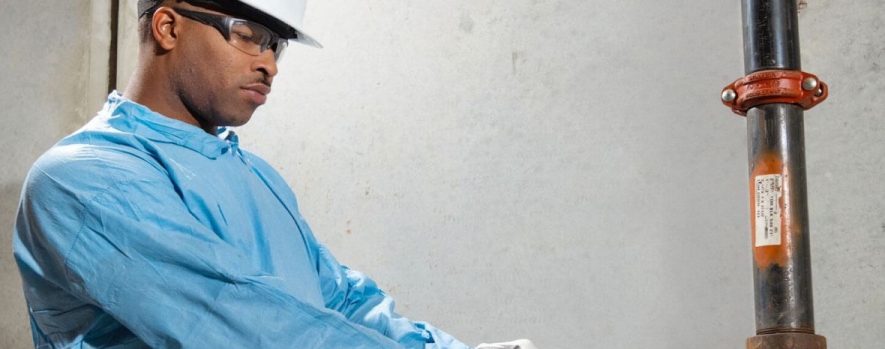
Many industries require the use of primary fire-retardant (FR) clothing to protect workers from flames or spark ignition that can be caused by an electric arc, combustible dust explosions, or flash fires. Electricians, chemical plant employees, pulp and paper industry workers, and those that work in the oil and gas industry face the greatest flame hazards during their normal work day.
If employees are normally exposed to flash fire risks, OSHA requires primary flame resistant clothing when working with molten metal, electric circuits over 600 volts, and within environments where the heat energy is estimated to exceed 2.0 cal/cm2.
Why Employees Need Disposable FR Coveralls
In many industries, workers are given fire and/or chemical coveralls as a source of primary work-wear when work activities include exposure to Non-Hazardous Aerosols and Particulates. In these cases, the coveralls act to protect the employee's clothing and to maintain a higher level of cleanness while keeping workers comfortable within the environment. Large restaurants, facilities crew,food and beverage processing , and pharmaceutical plants are just a few. These industries realize that normal work cloths such as jeans and tee shirts don't offer the level of protection from an unexpected mishap in places where electrical controls, spilled liquids, chemicals, and fast-moving machinery exist side-by-side.
In many other process or manufacturing industries, employees face real and sometimes constant work hazards and serious injury when they suddenly find themselves in one of the following sources of a flash flame:
- The escape of flammable gases
- Incidental contact with high-voltages
- Unexpected chemical process chain reactions
- Quick release of pressurized gases or chemicals
- Accidental flammable chemical spill
- Hot Works accidents - cutting, welding, soldering and brazing
Personal protective clothing can be a major expense for companies, therefore many are now extending the life of their worker's primary FR clothing that can quickly become compromised by workplace dirt, grime, and grease with secondary fire retardant disposable coveralls. Partner with a manufacturer that produces high quality, disposable FR coveralls that are rigorously tested to offer additional protection from fire or chemicals and will extend the life of your employee's primary FR clothing.
How Disposable FR Clothing is Used
When choosing a provider for outer-layer or secondary Disposable FR clothing, choose a manufacturer that adheres to American National Standard (ANSI) for Secondary Single-Use Flame Resistant Protective Clothing for use over Primary Flame-Resistant Protective Clothing guidelines, along with ASTM D6413 vertical flame testing. This way, you can be assured that the clothing meets the minimum performance and labeling requirements to protect employees and the underlying FR garment.
Disposable FR coveralls are the best solution to keeping primary FRC clean, OSHA compliant, and performing at a high level to protect the wearer. Disposable FR coveralls should not be used as the primary protection from burns or chemical spills, but are an additional layer of protection worn over the employee's approved FR clothing and can extend the life cycle of primary PPE.
Disposable FR coveralls will ignite when exposed to a flame, but will not continue to burn after removed from the source of fire, similar to other flame retardant materials. The chance of burn injuries are drastically reduced because the specially-engineered fabric of a disposable FR coverall will self-extinguish. These disposable garments can be reused if they are kept in good condition, but should be discarded if washed, contaminated, or damaged.
How to Choose Disposable FR Clothing
When choosing a provider for outer-layer or secondary Disposable FR clothing, choose a manufacturer that adheres to American National Standard (ANSI) for Secondary Single-Use Flame Resistant Protective Clothing for use over Primary Flame Resistant Protective Clothing guidelines, along with NFPA 2113 (section 5.1.9) requirements. This way, you can be assured that the clothing meets the minimum performance and labeling requirements to protect employees and the underlying FR garment.
Here are some other key features to look for when choosing disposable FR coveralls:
- The FR garment should pass ASTM D6413 vertical flame testing which measures the response of fabrics when exposed to heat and flames under controlled conditions.
- The material should be breathable and with a high moisture vapor transmission rate (MVTR) to help wearers feel cooler.
- Zippers should have an extra layer of protection such as a storm flap.
- Chemical and flame-retardant coveralls should have sealed seams for additional protection against liquid and chemical penetration
When choosing a secondary FR garment, the most important factor is the melting of the fabric which can drip. In a potential arc flash or high-voltage electrical incident NFPA states that material that melts and drips should be worn by workers. Always choose a garment that has met these standards as an indication of a higher-quality FR clothing product.
The durability of a disposable FR can be improved by storing the merchandise away from direct sunlight and high temperatures. They should be kept boxed, in a dust-free environment and protected from insect infiltration. Employees should be trained in detecting FR garments that are not fit for use, such as those that have rips, holes, or FR garments that are discolored.
Even when an FR coverall doesn't look damaged or contaminated, there are times when they should be removed from service more rapidly depending upon:
- The type and amount of exposure to chemicals
- The duration of wear and the tasks performed during exposure
- The industry worn, especially chemical, petrochemical, and metals refining industries
Partner with International Enviroguard for innovative, disposable protective coveralls garments that safeguard your people, your productivity and your operations. When workers are comfortable, they are confident. Our lightweight, breathable garments are made in different styles to fit the tasks and levels of protection needed by today's workers. Choose from a wide selection of personal protective clothing including garments designed to protect from dust, dirt, grime, asbestos, mold, blackwater, blood, bloodborne pathogens, sparks and flames, HCIDs and noxious chemicals.